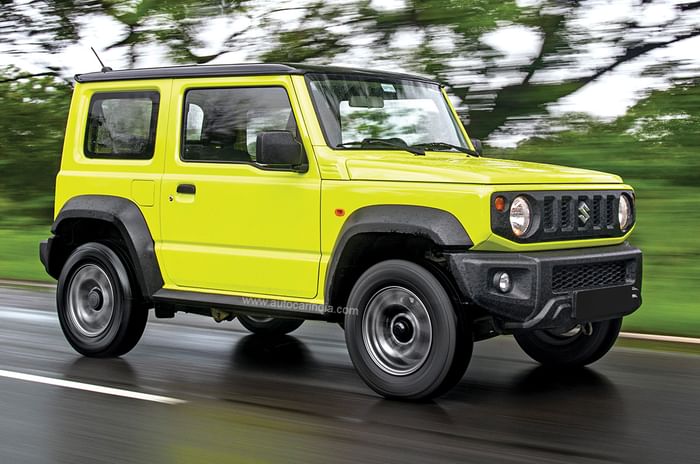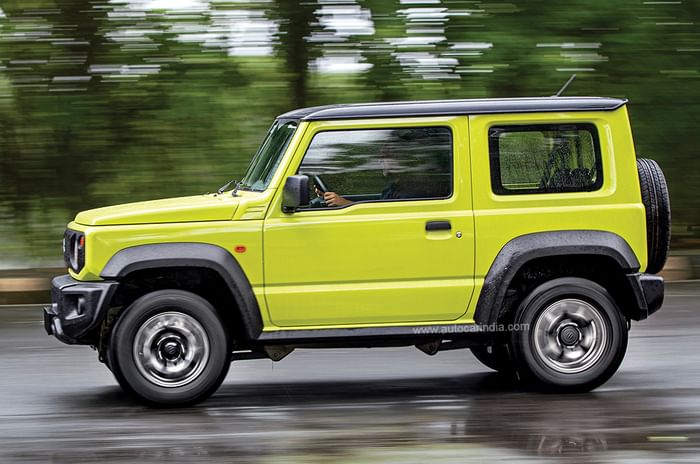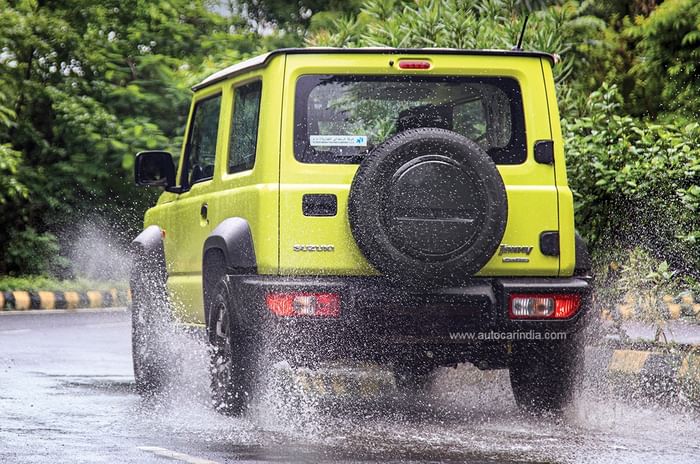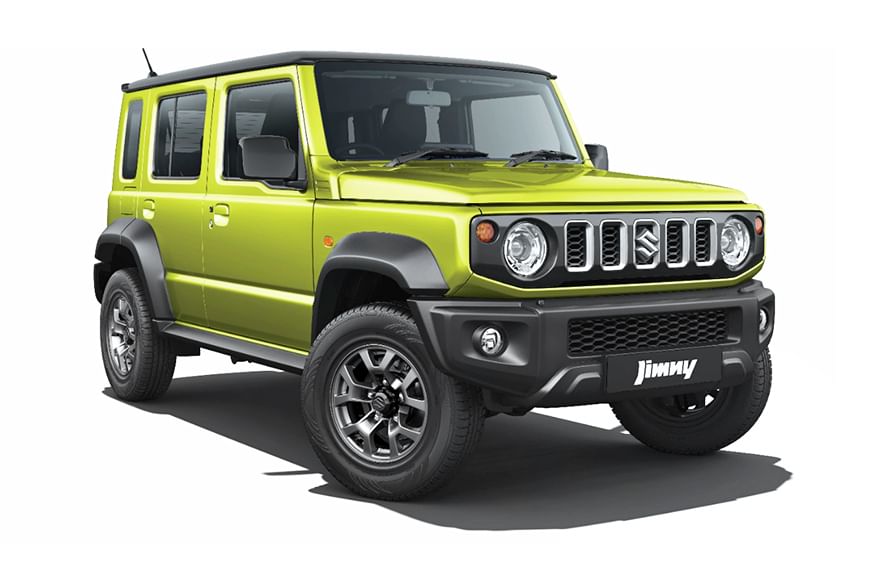Suzuki Jimny review: Turns more heads than a supercar
What is Suzuki’s most appealing Jimny like out and about on Indian roads? We get up close and personal.
Published on Aug 22, 2022 05:58:00 PM
86,086 Views
Follow us on
It’s probably the coolest, cutest off-roader ever to go into production. The cube-like dimensions lend it a visual symmetry that’s near perfect, the flat panels are designed with artistic sensibility and the chunky off-roader details are just spot on. The Jimny also just doesn’t have a bad angle. It draws so many appreciative glances as we drive along, we have to take care not to draw a crowd. Needless to say, everyone has their phone out, and everyone wants a picture.
As I take some pictures of the Jimny myself, floating somewhere in the back of my head are thoughts of the Mercedes G-Wagon. You see the ‘derived’ bits straight away. And the grille and headlight combo are pure Jeep, whatever Suzuki says. But the Jimny also has loads and loads of chutzpah and a character all its own.
 Even this three-door Jimny is made in India.
Even this three-door Jimny is made in India.
| Maruti Suzuki Jimny Price, Mileage, Specifications, Features and Variants | |
|---|---|
| Brand | Maruti Suzuki |
| Model Name | Jimny |
| Maruti Suzuki Jimny Price | ₹ 14.87 - 17.23 lakh |
| Maruti Suzuki Jimny Range/Mileage | Petrol : 16.39 - 16.94kpl |
| Maruti Suzuki Jimny Specifications | SUV | 5 doors | 4 seats View All Specs |
| Maruti Suzuki Jimny Features | LED headlight | 9-inch Touchscreen display | 6 airbags View All Features |
| Maruti Suzuki Jimny Variants | 1.5 Petrol Zeta MT | 1.5 Petrol Alpha MT | 1.5 Petrol Zeta AT View All Variants |
So why is Maruti not keen to launch such an attractive SUV in India? Especially since it actually manufactures it in Gurugram and exports it to the rest of the world. Even the identification plate on the firewall of this very car says ‘Maruti Suzuki India!’
Suzuki Jimny: powertrain
Part of the reason is that it isn’t your regular Suzuki soft-roader. Peer under the bonnet and things are very different. Clue number one is the longitudinally or north-south mounted engine. Then the drive goes straight to the rear wheels and this SUV is built on a ladder frame. Think Gypsy not Brezza and you’ll be on the right track. And Maruti could even call it the Gypsy or Grand Gypsy.
 4WD gets low range too.
4WD gets low range too.
Also important is that up front is a rigid axle. This is for better articulation when you are off-roading. The centre of the rigid axle works like a fulcrum, so when one wheel goes down, the other one gets pushed up. And that means better traction. The Jimny also gets low-range.
 4WD selector is just a lever.
4WD selector is just a lever.
The Gypsy’s stubby selector rod seems to have been carried over, and you can switch manually between ‘2WD-high’, ‘4WD-high’ and ‘4WD-low’. What you don’t get is a set of mechanically locking differentials. Suzuki instead uses an electronic traction control system that automatically brakes slipping wheels allowing torque to be redistributed to other wheels.

Built to adhere to pocket-size Japanese kei-car regulations – where do you think the logic for the sub-four metre rule comes from? The Jimny is also tiny by design; this international version is, however, a bit larger. Known as the Jimny Sierra, it is longer at 3.6 metres (believe it or not), it is 1.6 metres wide and 1.7 metres tall. Yes, it’s taller than it is wider. The Jimny three door also gets 210mm of ground clearance, an approach angle of 37deg and breakover and departure angles that are better than the Jeep Wrangler.
Suzuki Jimny: interior, features
Now taking the size into consideration, you’d expect Jimny to feel uncomfortable and restrictive. Nothing could be further from the truth. The square doors are just massive, open wide and allow you to just waltz in. Once inside the cube, the vertical walls make it feel spacious. There isn’t as much space as the Mahindra Thar, but then you don’t feel like you are sitting on top of the passenger either.
 The dash is funky, but there are plenty of cheap plastic bits too.
The dash is funky, but there are plenty of cheap plastic bits too.
The boxy dimensions also make for excellent visibility. The A-pillars are thick and provide some sense of security, but the view over the bonnet is also unrestricted and visibility on the move is very good. While the seats are typical Suzuki and soft, there is more bolstering and side support here than on others. Stiffer cushioning and wider seat would have been nicer still.
 Chunky dials are like those on the Gypsy.
Chunky dials are like those on the Gypsy.
Suzuki has also made an attempt to carry some design traits over from the earlier Jimny or Gypsy, so you see plenty of faux exposed bolts on the dash. The squared instrument panel, with individual blocks for the speedometer and tachometer remind me of the Gypsy, and then so does the grab handle that has been solidly integrated into the dash.
 Chunky grabrail is integrated.
Chunky grabrail is integrated.
There are plenty of familiar Maruti bits inside, too many to count and plenty of inexpensive looking black plastic, but the Jimny also gets chunky, easy to twirl air con knobs and piano-key like buttons with neat chrome highlights. Have to say I like the design of the dash and even the basic construction; it sort of feels functional.
 Power window switches in centre.
Power window switches in centre.
Getting into the rear also isn’t as bad as I expected it to be. This is because the front door is huge, the front seat slides all the way forward, and then all you need to do is bend a bit and walk in. The seats in the rear are small, low and there is only sufficient legroom. I can place my feet under the front and can recline the backrest. And then again, because of the square sides, I don’t quite feel hemmed in, but this clearly isn’t the place to enjoy a long drive.
 The rear seats are flat and there isn’t too much legroom.
The rear seats are flat and there isn’t too much legroom.
Also restricted is boot space. It, however, is cleverly designed and flexible. You can make a pair of cabin bags or strolleys stand up in the boot, with the backrests upright, and the seats split 50:50 if you want to travel three up with a bit of luggage. The rear seats also fold flat, resulting in up to 830 litres of space.
Suzuki Jimny: ride and handling
With the ladder frame and especially the rigid front axle, the Jimny clearly doesn’t ride like your everyday Maruti. Ride isn’t quite as bad as on a Gypsy, but you do bob along at low speed, especially on poorly paved surfaces. And over bad patches, the Jimny rocks back and forth too. The ride settles down a touch as you go faster, as the long travel suspension irons out the road better. Still, one thing’s for sure, Maruti will have to work hard to get the four-door Indian version to ride well and handle safely, and that will be a challenge. Remember Suzuki had to widen the track of the longer wheelbase Gypsy here in India too; the widened cars getting the ‘W’ designation.

Having driven the Jimny on an earlier occasion, I can also tell you the steering is also not what you expect. This is partly because it gets a recirculating ball set-up as against a rack and pinion system, and the weighty solid axle in the front also has a tell-tale effect. Better suited for off-road driving, (something I haven’t managed to do in the Jimny yet), it gets 3.9 turns lock to lock and needs a fair amount of twirling.
 Only drum brakes in the rear.
Only drum brakes in the rear.
This in general is fine on a straight stretch of road. But it can get galling when you have to weave in and out of traffic, and then, around corners, the Jimny isn’t exactly agile. There’s some amount of flop, grip from the narrow tyres isn’t very good, the slow steering feels out of sync and the Jimny in general seems happier being driven in a more relaxed manner.
This actually dovetails nicely with the engine and performance on offer. The engine used is the familiar K15B, which makes around 102hp. While power is sufficient for the kerb weight of around 1.2 tons, the four speed automatic gearbox saps a fair amount of juice. It’s fine in slow moving traffic and initial responses are good, but the engine needs more grunt in the midrange. This means you need to rev it hard to get it to deliver power. And that means it is straining all the time. Expect a 0-100kph time of around 12-and-some seconds for the five door, if we get the same engine. And what also feels old school on this car, and surprisingly so, are the brakes.
Suzuki Jimny: India sale
It’s not difficult to understand why Maruti would rather sell a five-door version of the Jimny in India. Space, comfort, practicality are all likely to be superior. And the five door will upgrade the Jimny from being primarily a recreational off road with some amount of practicality into one that can double up as a family car.
That said, the fact that Maruti hasn’t launched the three-door Jimny in India yet, despite the car being made here, is sort of tragic. Extremely attractive, functional and usable on an everyday basis, especially if you don’t need to use the rear seats all the time, the Jimny, like the Mahindra Thar, would make for an ideal second, or even third car. It is, in fact, so attractive it may even outsell the five door. And maybe that’s why it isn’t on sale yet.
Also read:
Suzuki Jimny 5-door spied; Auto Expo 2023 debut likely
Tech Specs 
Copyright (c) Autocar India. All rights reserved.





 Price
Price Engine
Engine Transmission
Transmission Body
Body Dimensions
Dimensions
Comments
Member Login
Personal Details
No comments yet. Be the first to comment.